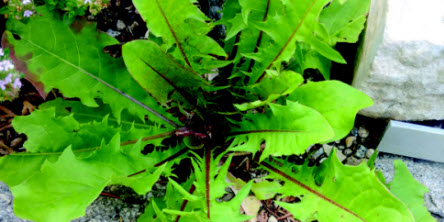If your garden is overgrown with weeds, you can always eat some of them and do your health a favour at the same time.
Purslane, sometimes called portulaca, is very nutritious, with ten times as much omega 3 fatty acids than found in spinach. Purslane is that fleshy looking weed, whose red stems and oval leaves hug the ground, sending down new roots at each node. It makes a tasty substitute for fish oil and is high in vitamin C.
Steamed, it tastes like spinach. Served raw it tastes like pea shoots and is wonderful in salads. Both the leaves and the stems are delicious.
Purslane produces little yellow flowers that soon become capsules of tiny seeds. (Beware of a poisonous imitator, which often grows close by. It is easy to identify by the milky sap it exudes when the wiry, rather than thick, stem is broken.)
Burdock (Arctium lappa) is that nuisance weed responsible for the burs that get stuck in pet fur and pant legs. But it has virtues that make all that worthwhile. Young burdock leaves can be eaten in salads or the roots can be mashed, formed into cakes and fried in butter. The stalks can be peeled and used like celery and even the flowers can be used when simmered in syrups and eaten like candy.
Burdock is very high in nutrition including inulin, a naturally occurring phytochemical that mimics the actions of insulin. Burdock was traditionally used as a blood purifier and as a diuretic. It was also used to clear the skin of acne, eczema and psoriasis because it has anti-inflammatory, anti-oxidant and antibacterial properties. It is said that the root is effective in removing heavy metals from the body.
Dandelion greens have long been known for their use in salads. Use very young leaves and, if you don’t like bitter, cook them with eggs, bacon or all three, or collect them in fall when the bitterness has dissipated. Roots can be sautéed or ground up as a coffee substitute. And, of course, the flowers are famous for dandelion wine.
Dandelion greens are four times higher in vitamin A than broccoli and twice as high in vitamin K. They are an excellent diuretic as attested to by their French common name of pissnelit or “pee the bed.”
This is just a small glimpse at the virtues of dandelions, which were actually brought to North America by Europeans, who couldn’t fathom living without their healing ad healthful properties.
Nettle. It wouldn’t do to talk about edible weeds without mentioning stinging nettle (Urtica dioica). Young leaves are an excellent source of iron and can be cooked in soups. (When the leaves and stems are cooked or dried, the stingers lose their sting).
According to Manitoba Food and Agriculture: “Today, stinging nettle is in demand as a treatment for non-cancerous prostate enlargement, for high blood pressure and urinary tract infections. It is used to treat skin eruptions and eczema, and freeze-dried as a treatment for hay fever.”
There is a book that will tell you 101 ways to used stinging nettle for healing purposes. Collect them (wearing gloves, long sleeves and pants) in spring before they flower.
Plantain. The broadleaf kind, not the banana imitator, should be a diet staple, according to some. This little hosta lookalike is chock full of iron, vitamins and minerals. Harvest the tender young leaves, which taste like asparagus if you fry them up in olive oil.
Okay, so you prefer to go to the supermarket for your veggies, but now you can rest easy knowing that if climate change kills off all other plants, the weeds will still be there to nourish you and your family.



